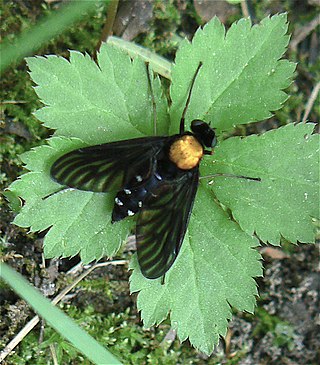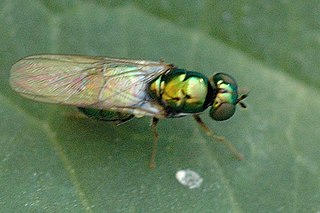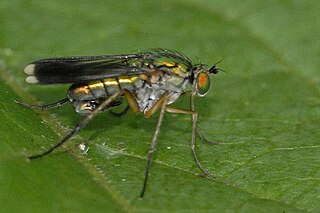
The Brachyceran infraorder Xylophagomorpha is a small group that consists solely of the family Xylophagidae, which presently contains subfamilies that were sometimes considered to be two small related families. Other obsolete names for members of this family include Exeretonevridae and Heterostomidae.

Chrysopilus is common, worldwide genus of predatory snipe flies. There are approximately 300 species in the genus, including fossil members that are sometimes found in amber.

Microchrysa is a genus of soldierfly belonging to the family Stratiomyidae. There has been some confusion with the synonym Chrysomyia of Macquart, 1834, causing some members of the genus Chrysomya of Robineau-Desvoidy, 1830 to be placed erroneously in this genus.

Sybistroma is a genus of flies in the family Dolichopodidae. It includes over 50 species, described mainly from the Palaearctic and Oriental realms. A single species is known from the Afrotropical realm. Until 2005, the genus was thought to be restricted to the Mediterranean in distribution, with five known species. It was recently expanded to include the former genera Hypophyllus, Ludovicius and Nodicornis, as well as some species of Hercostomus.
Spania is a genus of snipe flies of the family Rhagionidae.

The Brachyopini is a tribe of hoverflies. Unlike many members of this family these flies are generally darker and less colourful though some genera contain species with an attractive metallic lustre e.g. Chrysogaster. Some like Brachyopa are associated with sap runs where their larvae feed on decaying sap. Others are found in boggy areas where their often semiaquatic larvae feed on decaying organic matter.

Hybotinae is a globally widespread subfamily of hybotid flies.

Pachygaster is a genus of flies in the family Stratiomyidae.

Oxycera is a genus of flies in the family Stratiomyidae.

Oxycera pardalina, the hill soldier, is a European species of soldier fly.

Clitellaria is a genus of flies in the family Stratiomyidae.

Rachicerus is a genus of flies in the family Xylophagidae.

Atherix is a genus of 'ibis flies' belonging to the family Athericidae, a small family very similar to the Rhagionidae. Species within this genus are present in most of Europe and also in the Nearctic realm.

Solva is a fly genus in the family Xylomyidae, the "wood soldier flies".

Poecilobothrus is a genus of flies in the family Dolichopodidae.

Xylophagus ater is a species of awl fly belonging to the family Xylophagidae found in Central Europe and North Europe.

Xylomya is a fly genus in the family Xylomyidae, the "wood soldier flies".

Adoxomyia is a genus of soldier flies in the family Stratiomyidae.

The Brachyopina is a subtribe of hoverflies.


















